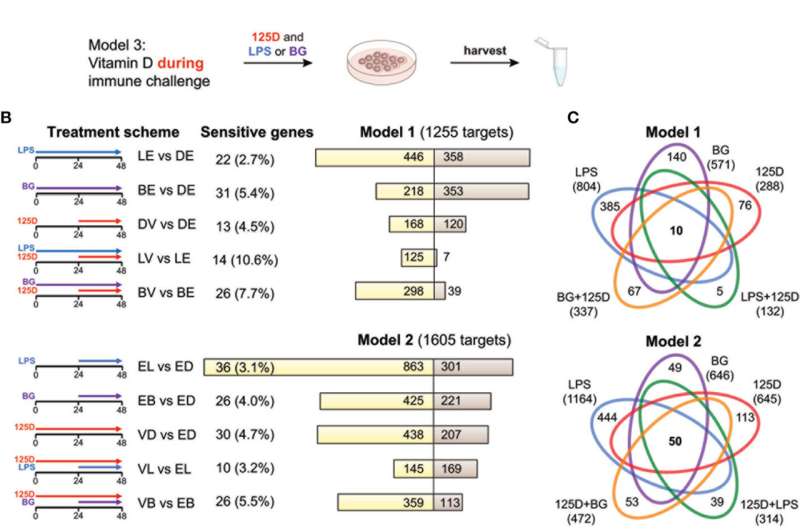Role of a good vitamin D status in fighting infections

A new study from the University of Eastern Finland highlights the benefits of a good vitamin D status in fighting infections. The researchers exposed human blood immune cells to molecules from infectious bacterial and fungal pathogens. In addition, the cells were treated with vitamin D before, after or in parallel with the pathogenic stimuli. Vitamin D was shown to modulate the cellular transcriptomic responses to immune challenges in all experiments, but it was more effective when administered before the pathogenic exposure.
"This suggests that when it comes to fighting infections, it is clearly better to takevitaminD supplementation in a preventive manner, rather than starting to take it when already infected," says the director of the study, Professor Carsten Carlberg.
Vitamin D has an important role in supporting the immune system, and its deficiency has been associated with increased complications of infectious diseases. Carlberg's research group was interested in finding out whether it is critical to have a sufficient vitamin D status before, during or after experiencing an infection. The first author, Henna-Riikka Malmberg, was a Master's student from Carlberg's group who completed her studies with this research.
For this purpose, human peripheral blood mononuclear cells were stimulated with either of the two molecules commonly used to study theimmune response: lipopolysaccharides found on the outer membrane of Gram-negative bacteria, or beta-glucan found in the cell wall of the fungus Candida albicans. In addition, they were treated with the biologically active form of vitamin D3, 1,25(OH)2D3. In the first study model, the cells were first exposed to the immunechallengefor 24 hours and then to vitamin D for another 24 hours, mimicking the situation where an individual is infected at a low vitamin D status and vitamin D is used for treatment. In the second model, the order was reversed, and the cells were first exposed to vitamin D and then to the immune challenge, mimicking an infection occurring at a high vitamin D status. In the third model, the immune challenge and vitamin D were applied simultaneously for 24 hours. Biological pathway analysis of transcriptome-wide results indicated the functional consequences of the observed changes ingene expression.
After exposures to bacterial lipopolysaccharides or fungal beta-glucan, significant changes were observed in the expression of 1,580 and 966 genes, respectively. However, in the presence of vitamin D, the number of genes responding to the immune challenges was up to two thirds smaller. A total of 1,006 genes responded to vitamin D. The genes responding to the different immune challenges and to vitamin D varied depending on the study model, suggesting that the treatment sequence has a major impact on the responsiveness of thecells.
Published inFrontiers in Immunology,这项研究提供了一个transcriptome-wide视图how vitamin D modulates responses of the innate immune system to immune challenges like bacterial and fungal infections. The authors point out that vitamin D3 supplementation will improve the vitamin D status of an individual, leading to a more effective signaling of the transcription factor vitamin D receptor via its target genes. Since a large number of these responsive genes are involved in improving the functionality of immunity, their vitamin D-triggered activity can be regarded as training of the innateimmune systemto fight infections. This suggests that vitamin D3 supplementation may have an important role in preventing infectious diseases or reducing their severe consequences.
更多的信息:Henna-Riikka Malmberg et al, Vitamin D Treatment Sequence Is Critical for Transcriptome Modulation of Immune Challenged Primary Human Cells,Frontiers in Immunology(2021).DOI: 10.3389/fimmu.2021.754056



















